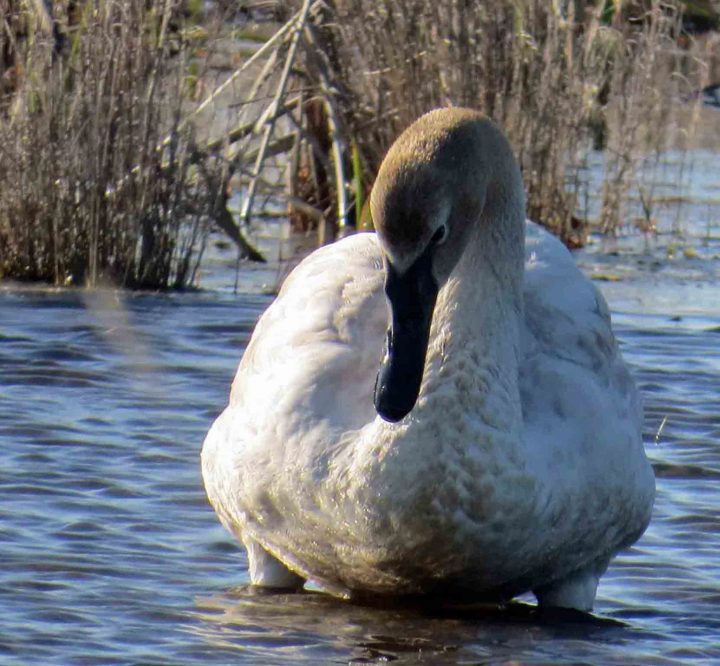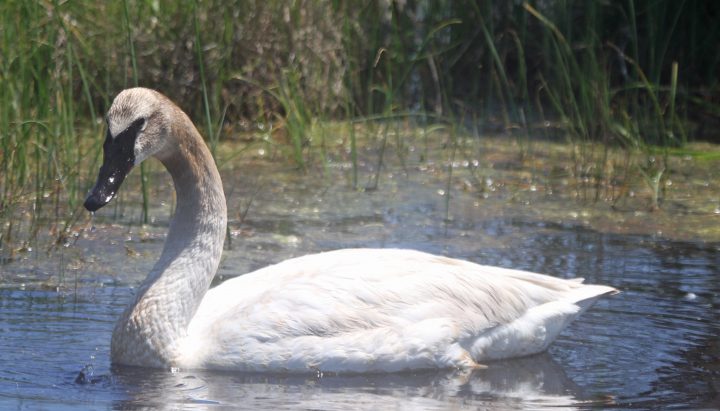
Reprinted from the Ocracoke Observer. Read an earlier story about this swan.
The young trumpeter swan’s two-month sojourn on Ocracoke appears over. May 2 was the last time it was reportedly seen where it had been feeding for the last two months along Southpoint Road. Should, by chance, it reappear, we will post an update.
Supporter Spotlight
This species, the largest North American waterfowl with an 8-foot wingspan and weighing up to 32 pounds, was a highly unusual avian visitor, in the league of the two Snowy Owls that spent the winter on the island’s dunes in 2014.
It was first brought to my attention by Denny Dobbin. A frequent visitor from Chapel Hill, he sent a text that he saw a swan at dusk in the ditch along South Point Road on March 5 and watched it fly in the direction of Springer’s Point.
Subsequently, many people noticed the swan as it adopted the marsh area near the beginning of Southpoint Road. It was seen daily, sometimes at a distance at the back of the marsh, other times, close to the sandy road, permitting many striking photographs. It became a favorite for social media posters on Facebook.
When first reported, many — including myself — assumed it was a tundra swan (Cygnus columbianus). Although not common on Ocracoke, tundras have never been reported on the islands Christmas Bird Counts which have run since 1981. They winter in large numbers in the region, particularly in the Lake Mattamuskeet National Wildlife Refuge area of mainland Hyde County and the Pea Island Wildlife Refuge on the Outer Banks.
Up until now, trumpeter swans (Cygnus buccinator) have not been reported on the Outer Banks.
Supporter Spotlight

While adult trumpeter and tundra swans can be identified by the tundra’s yellow lore, which is the space between bill and the eye, subadults can be more challenging. Since this was a first-year bird, called a cygnet, several field factors had to be considered to determine that it was a trumpeter.
Size can be a factor when the two species are together since trumpeters are larger and longer necked, but when a bird is solo, determining its species takes more observation. The plumage of a trumpeter cygnet is darker and the forehead has a V-shaped border while the Tundra has a U-shape.
But the best diagnostics is voice. Trumpeter swans make a soft honk, sometimes in a series of two to three notes “do-do-doo” that has been compared to a trumpet, hence its name. Tundra Swan calls are varied and include various bugling notes and a whistle sound. North American Tundra Swans were formerly known as Whistling Swans.
This video was made on a windy day by Beth Layton that provides its call. You might need a headset to hear it.
“I listened to the video,” said Margaret Smith, executive director of the Trumpeter Swan Society. “It sounds to me like a cygnet distress call, calling for other swans. When it makes repeated short calls like that in my area, usually the cygnet is separated from its family and calling for it, not loud, just repeated.”
It is noteworthy that this swan appeared on the island after a nor’easter, but it’s a mystery as to where it was previously. In migration, first-year trumpeter swans normally flock with their parents and other swans. This one had no bands that could provide some information.
Perhaps the storm caused it to be separated. Once it arrived on the island, it appeared to be healthy with a good appetite, spending long portions of the day feeding on the marsh vegetation. It was also very vocal, making single call notes.
When the cygnet was still on the island a few weeks after the Tundra Swans in the region had left for nesting in the far north, I wondered whether a young bird, separated and alone, has an instinct to migrate and if it could survive the hot temperatures of an Ocracoke summer.
I turned to the Trumpeter Swan Society, Plymouth, Minnesota. For the past 50 years, this nonprofit has been an important resource for providing expertise, research, monitoring, funding and on-the-ground support toward every major trumpeter swan conservation effort, restoration project and management activity.
“We don’t know if the swan will migrate or not,” said one of their biologists, Dr. Gary Ivey, on April 26. “It is pretty late in the season to be migrating and it very well could, but it may stay there all summer until next fall’s wintering swans come down.” He also noted it would not be too warm for the swan spend the summer here.
Here is a little history on this swan and its amazing comeback.
Once common across most of the northern United States, by the 1880s trumpeter swans had pretty much disappeared, having been hunted for their meat, soft skins used in powder puffs and feathers for quill pens and hats.
The Passage of the Migratory Bird Treaty Act of 1918 gave protection to trumpeter swans and many other bird species and helped curb illegal killing.
But whereas many endangered birds made a comeback under this act, it did not help the trumpeter swan. By the early 1930s, only 69 trumpeter swans were known to exist in the lower 48 states in a remote location of Yellowstone.
The Director of the U.S. Fish and Wildlife Service in a 1949 report considered trumpeter swans “the fourth rarest bird now remaining in America.”
Here is where the good news begins. In 1956, Melvin Monson, a scientist with the Fish and Wildlife Service, published an article in the ornithology journal, “The Condor,” that a previously unknown population of trumpeter swans was discovered in the lower Copper River Basin of Alaska.
As more trumpeter swans were discovered in Alaska and western Canada, by relocating some of the swans and eggs from these areas, restoration efforts in the 1960s began in earnest by states and provinces.
In 1968, the first North American Trumpeter Swan Survey (NATSS), a major cooperative effort by federal, state and provincial governmental agencies, took place. A tally of 2,752 swans were reported. The next survey in 1975 reported 3,727 individuals. The survey now runs on five-year intervals and it has shown significant increases with each survey. The two most recent are 2010: 34,249 and 2015 nearly doubling, 63,016. The big increase is in Alaska. However, the midwestern (Mississippi and Atlantic Flyways) population increased significantly as well with a count of 26,591.
‘The Carolina Bird Club provides a wealth of information and photographs of birds of the Carolinas. It produces a journal, the Chat, and a records committee that reviews reports of rare birds.
The following are some edited Trumpeter Swan records and reports available on its website:
- A group of four trumpeter swans was banded on Feb. 25, 2004, at the Pungo unit of Pocosin Lakes National Wildlife Refuge by U.S. Fish and Wildlife Service staff. This is a first record for the state. The Committee reviewed many websites and email correspondences regarding re-introduced populations in the East and Midwest. The general feeling was that the birds were probably not vagrants from the natural range in the Far West but rather from populations in the Great Lakes region.
- A subadult was photographed on Jordan Lake, Chatham Colorado, on Dec. 19, 2013. Another was seen in the Pungo Unit of Pocosin Lakes National Wildlife Refuge border of Hyde and Washington counties, on Feb. 7, 2014. It’s not certain whether these two sightings were of the same bird.
- Two were seen in the Pungo Unit of Pocosin Lakes National Wildlife Refuge, Hyde County, in January 2015.
- Two were seen at Mattamuskeet National Wildlife Refuge, on December 20, 2015.
- In the Pungo Unit of Pocosin Lakes National Wildlife Refuge, Washington County, a high count of three was made Jan. 14, 2017.
- A report of a subadult trumpeter swan on the French Broad River near Alexander, Buncombe County, was made on Dec. 25, 2016 and stayed through March 27. If accepted, it would be the first record of this species in the mountain region.

The cygnet made an impression on many.
Beth Layton, the Ocracoke high school math teacher, was one of them.
“I first saw the trumpeter swan on March 17 – Saint Patrick’s Day – and I felt lucky indeed,” she said. “As a matter of fact, I whispered ‘thank you, God!’ when I got my first glimpse.
“Almost every day after school, I walk several miles. Usually I go to the beach. If the wind is too bad, I’ll walk in the village. Once the swan arrived, I always started my walks on South Point Road. It was mesmerizing, calming, fascinating,” she said. “And now he has left us, and a little part of me is sad to know that he won’t be part of my daily walk. What I really want to know now is that he made it safely to wherever he belongs, that his instincts led him back there. This experience with the trumpeter swan feels like yet another gift in my time here on Ocracoke.”
Margaret Smith, who has been following the updates I have been sending her, finds the cygnet’s presence here intriguing.
“It is exciting to get reports of swans in the eastern United States,” she said. “Trumpeter swans are slowly but surely finding their way to new areas in the Atlantic Flyway. You are seeing the pioneering swans making history in your area! How absolutely thrilling.”
So where is the swan now? We hope it has headed to somewhere in the Midwest to join other trumpeters. Since this cygnet is so large, perhaps we will hear of a report of a sighting on its way.
North Carolina might see more of these swans with the increase of nesting birds about 1,500 or so miles away, instead of a rare stray from Alaska.
Maybe it will return next winter to Ocracoke and bring a few friends. The small marsh where it spent time here appeared to be a suitable habitat.
This story is provided courtesy of the Ocracoke Observer, a newspaper covering Ocracoke island. Coastal Review Online is partnering with the Ocracoke Observer to provide readers with more environmental and lifestyle stories of interest along our coast.








